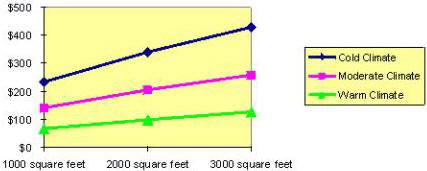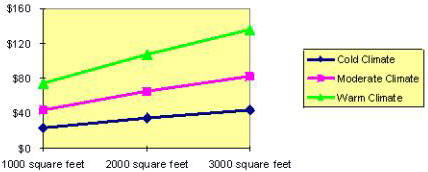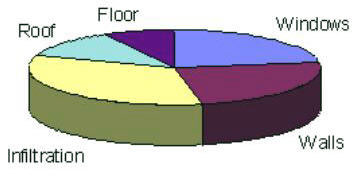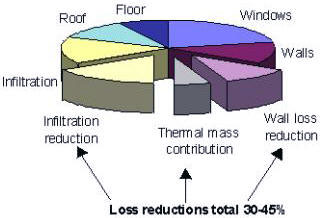Save Energy, Save Money!
Financial Benefits | Environmental Benefits | Health & Safety | Durability | Comfort & Quiet | FAQs
Concrete buildings save energy
Building a concrete structure with insulating concrete forms (ICFs) saves energy and money. The greater insulation, tighter construction, and temperature-smoothing mass of the walls conserve heating and cooling energy much better than conventional wood-frame walls. This reduces monthly fuel bills. It also allows the use of smaller heating and cooling equipment, saving money in construction.
How much will I save?
Buildings constructed with ICF exterior walls require an estimated 44% less energy to heat and 32% less energy to cool than comparable frame structures. A typical 2000 square foot building in the center of the U.S. will save approximately $200 in heating costs and $65 in air conditioning each year.
The bigger the building, the bigger the savings. In colder areas of the U.S. and Canada, heating savings will be more and cooling savings less. In hotter areas, heating savings will be less and cooling savings more.
Estimated Annual Heating Savings

Estimated Annual Cooling Savings

The smaller heating and cooling equipment needed for such an energy-efficient building can cut construction costs by an estimated $500 to $2000. The biggest equipment savings come with the buildings that have the most energy savings.
How do we know all this?
The energy savings estimates come from a study of single-family houses spread across the U.S. and Canada. Researchers gathered data on 58 houses in all. Half had exterior walls constructed with concrete using ICFs made of expanded polystyrene (EPS) or extruded polystyrene (XPS) foam. The other half were neighboring houses with walls constructed of wood frame. All houses were relatively new (less than 6 years old) and built with modern methods.
The researchers compared the energy bill of each concrete house to its frame counterpart, carefully correcting for important differences to get an “apples-to-apples” comparison. Estimates of equipment savings are actual numbers reported by contractors that build ICF houses.
Where do the savings come from?
Insulating values for ICF walls using polystyrene foam are R-17 to R-26, compared to wood frame’s R-9 to R-15. So ICF walls are expected to cut the conduction losses through foundation and above-grade walls by about half. And ICF walls are tighter. In tests, ICF houses averaged about 1/2 as much infiltration (air leakage) as frame.
Sources of Energy Loss

Energy Loss Reduction

ICF walls do more than cut down on the biggest types of energy loss. The concrete gives them the heat-absorbing property, “thermal mass”. This is the ability to smooth out large swings in temperature. It keeps the walls of the building warmer when the outdoor temperature hits its coldest extreme, and keeps them cooler when the outdoor temperature is hottest. The walls themselves “add back” heat or cooling to the building when it needs them most. This contributes about 6% of the structure's required energy for free.
Reduced equipment costs result from the energy savings. Since the energy needed is less, the furnaces and compressors that heat and cool can be smaller. And the more the energy savings, the greater the possible reduction in equipment size—and the equipment cost.
What's the bottom line?
In planning a building, you can estimate that choosing concrete walls made of ICFs will save you hundreds of dollars per year in energy costs. As shown in the graphs, the savings are greater the bigger the building is. Heating savings are highest in cold climates, and cooling savings highest in warm climates.
You may also save hundreds or thousands of dollars in construction costs for heating and cooling equipment. Talk with an ICF supplier or contractor for estimates.


